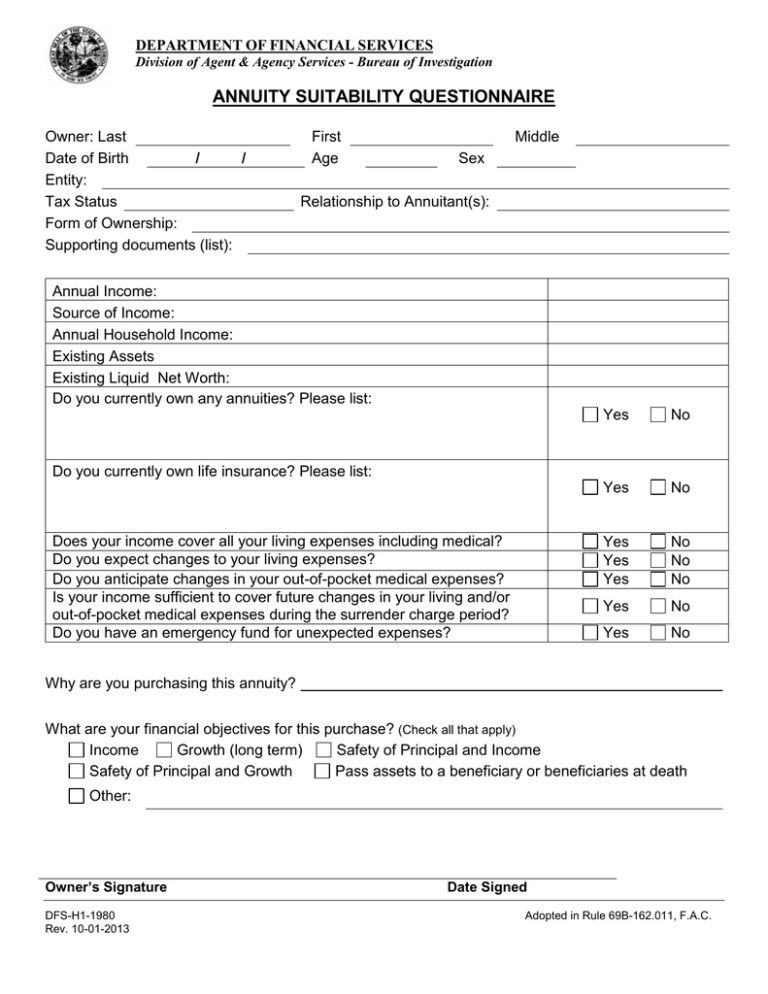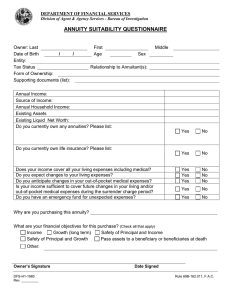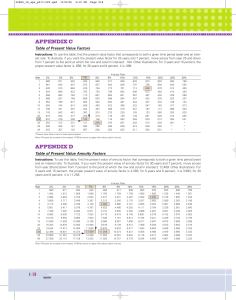ANNUITY SUITABILITY QUESTIONNAIRE
advertisement

DEPARTMENT OF FINANCIAL SERVICES Division of Agent & Agency Services - Bureau of Investigation ANNUITY SUITABILITY QUESTIONNAIRE Owner: Last Date of Birth / / Entity: Tax Status Form of Ownership: Supporting documents (list): First Age Middle Sex Relationship to Annuitant(s): Annual Income: Source of Income: Annual Household Income: Existing Assets Existing Liquid Net Worth: Do you currently own any annuities? Please list: Yes No Yes No Yes Yes Yes No No No Yes No Yes No Do you currently own life insurance? Please list: Does your income cover all your living expenses including medical? Do you expect changes to your living expenses? Do you anticipate changes in your out-of-pocket medical expenses? Is your income sufficient to cover future changes in your living and/or out-of-pocket medical expenses during the surrender charge period? Do you have an emergency fund for unexpected expenses? Why are you purchasing this annuity? What are your financial objectives for this purchase? (Check all that apply) Income Growth (long term) Safety of Principal and Income Safety of Principal and Growth Pass assets to a beneficiary or beneficiaries at death Other: Owner’s Signature DFS-H1-1980 Rev. 10-01-2013 Date Signed Adopted in Rule 69B-162.011, F.A.C. Describe your risk tolerance: (Check all that apply) Conservative Moderately conservative Aggressive Moderate Moderately aggressive Other: Comments: Describe your investment experience by type and length of time: What is the source of the funds for the purchase of the proposed annuity? How many years from today will you need access to your funds without a penalty? Will the proposed annuity replace any product? Yes No If yes, will you pay a penalty or other charge to obtain these funds? Yes No If yes, the amount of the charge or penalty $ Additional Information: Owner’s Signature DFS-H1-1980 Rev.10-01-2013 Date Signed Adopted in Rule 69B-162.011, F.A.C. Page 2 of 4 Note: This section to be completed by the agent, insurer, or Managing General Agent proposing purchase Advantages of purchasing the proposed annuity: Disadvantages of purchasing the proposed annuity: The basis for my recommendation to purchase the proposed annuity or to replace or exchange your existing annuity (ies): Agent’s Signature Date Signed Note: No questions or response areas are to be left blank when offered to the Owner for signature. If any information requested is unavailable, not applicable or unknown, the insurance agent or insurer must indicate that. ACKNOWLEDGEMENTS AND SIGNATURES I understand that should I decline to provide the requested information or should I provide inaccurate information, I am limiting the protection afforded me by the Florida Statutes regarding the suitability of this purchase. I REFUSE to provide this information at this time. I have chosen to provide LIMITED information at this time. My annuity purchase IS NOT BASED on the recommendation of this agent or the insurer. My annuity purchase IS BASED on the recommendation of this agent or the insurer. APPLICANT: DO NOT SIGN THIS FORM IF ANY ITEM HAS BEEN LEFT BLANK, BEFORE CAREFULLY REVIEWING THE INFORMATION RECORDED, OR IF ANY OF THE INFORMATION RECORDED IS NOT TRUE AND CORRECT TO THE BEST OF YOUR KNOWLEDGE. THE OWNER MAY SUBSTITUTE THEIR INITIALS FOR SIGNATURES ON ALL FORM PAGES WITH THE EXCEPTION OF THE SIGNATURES BELOW, WHICH ARE REQUIRED. Owner’s Signature DFS-H1-1980 Rev.10-01-2013 Date Signed Adopted in Rule 69B-162.011, F.A.C. Page 3 of 4 EXPLANATION OF T ERMS “Age” is the natural person’s attained age on the day the form is completed. “Tax Status” is the owner’s Federal Income Tax filing status such as “single” or “married filing jointly”; if “Exempt”, so state. “Form of Ownership” is the type of entity, other than a natural person, including a corporation, trust, partnership, limited liability company, or other business or not-for-profit entity. “Supporting documents” are the documents that provide a basis for the relationship between the Proposed Annuitant, and the Owner as it may exist. “Annual income” is income received during a calendar year, whether earned or unearned. “Source of annual income” is the income-generating source, such as pension income, dividends, or earned income etc. “Annual household income” is the combined annual income received by all household members each calendar year. “Existing Assets” are financial assets including life insurance and annuities. “Existing Liquid Net Worth” is applicable to those net assets that can readily be converted into their cash equivalent, without loss of principal after all surrender charges or other deductions have been taken .“Financial Objectives” are the owner’s stated goals as described to the insurance agent or insurer, if no insurance agent is involved. These may include but are not limited to the following: (1) Income, (2) Growth (long term capital appreciation), (3) Safety of Principal and Income, (4) Safety of Principal and Growth, (5) To pass the investment to a beneficiary or beneficiaries at death. “Risk Tolerance” means the degree of uncertainty that an investor can reasonably tolerate with regard to a negative change in his or her investments. Examples of risk tolerance levels may include the following: (1) Conservative (prefer little or no risk), (2) Moderately conservative (some risk, reduced safety of principal), (3) Moderate (average risk with potential losses and potentially higher returns), (4) Moderately aggressive (above average risk with potential losses, risk of principal and potentially higher returns), (5) Aggressive (willing to sustain losses or loss of principal in pursuit of higher returns). “Source of the funds” to be used to purchase the proposed annuity means from where the funds will come to purchase the annuity, and may include but are not limited to; (1) An existing annuity or life insurance contract, (2) Liquid Assets, including but not limited to, cash in banks, maturing certificates of deposit, and money market accounts, (3) Personal Loans, (4) Equity Loans, (5) Mortgages, Reverse Mortgages, (6) Death Benefit Proceeds, (7) Funds received upon retirement from employment, including but not limited to, 401(k) accounts, pensions, and other tax-sheltered funds, (8) Equities, mutual funds, or bonds, (9) Proceeds from real estate transactions. Owner’s Signature DFS-H1-1980 Rev.10-01-2013 Date Signed Adopted in Rule 69B-162.011, F.A.C. Page 4 of 4






